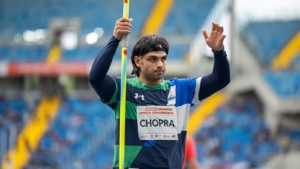India’s skeet shooters returned empty-handed from the ISSF Shotgun World Cup in Lonato, Italy, as none of the country’s representatives could make the finals in either the men’s or women’s skeet events.
After three days of intense qualifying rounds that tested skill, rhythm and mental fortitude, the Indian contingent fell short of the mark needed to break into the top-six finals bracket.
Mairaj Ahmad Khan Leads, But Misses the Cut
Senior pro and Olympian Mairaj Ahmad Khan was India’s best performer on paper in the men’s skeet, but even he couldn’t find the extra edge to crack the finals lineup. Mairaj, who came into the final day with 100 hits out of 100 targets after four solid rounds, looked set to mount a serious challenge for the top-six berth. However, a score of 23 out of 25 in his fifth and final round proved costly. He ended with an aggregate of 121/125, placing him 34th in a field of 176 shooters well adrift of the cut-off mark for the finals.
For Mairaj, who has carried the Indian skeet hopes on his shoulders for more than a decade, this result will sting. A two-time Olympian and the country’s most experienced skeet marksman, the 49-year-old remains one of India’s best exponents of the discipline, but the increasingly high standards in world skeet mean even a single missed target can be decisive.
Young Guns Fall Short
Among the other Indian men in action, Anant Jeet Singh Naruka, who competed at the Paris Olympics last year and is regarded as one of the country’s brightest young hopes in the discipline, shot a total of 119, landing him in 64th place. Naruka has shown glimpses of promise on the international circuit but has yet to find the consistency needed to match the very best in high-pressure finals at the ISSF level.
Another upcoming name, Bhavtegh Singh Gill, also returned a score of 119, finishing slightly behind Naruka in 75th place. For both Naruka and Gill, the outing in Lonato will serve as another important learning curve, highlighting the work needed to close the gap with the world’s elite.
Women’s Skeet: Missed Targets, Missed Opportunity
In women’s skeet, India’s campaign didn’t fare much better. Maheshwari Chauhan, who competed at the Paris Olympics and has multiple international appearances under her belt, finished 31st with a total of 116 hits. Her score left her well short of the top-six cut required for the finals.

Fellow Indian shooters Ganemat Sekhon, a World Cup medalist and one of the faces of India’s new generation in women’s skeet, finished 35th, while Raiza Dhillon, another Paris Olympian, placed 40th. The trio, who have shown promise on the continental stage, were simply unable to find the higher scores required in the tough Lonato conditions that traditionally see strong European and American competition.
The Rising Bar in World Skeet
The results in Lonato are a sharp reminder of the level at which skeet shooting is contested internationally. The world’s best shooters are separated by razor-thin margins. At the top, USA’s Vincent Hancock, a five-time Olympic medalist and one of the sport’s greatest ever, clinched the men’s skeet gold after an intense shoot-off against Henrik Jansson. Hancock’s performance underlines the bar that Indian shooters need to clear to make podium finishes routine at this level.
In the women’s field, Samantha Simonton of the USA took gold, continuing America’s stronghold over the skeet discipline, while China’s Jiang Yiting picked up bronze a testament to the strength of Asian shooting powerhouses who consistently produce world-class skeet shooters.
Cause for Reflection
For India, the blank scorecard in Lonato will spark another round of introspection about the future of skeet shooting in the country. While India’s shotgun shooters in trap and double trap have made the finals and won medals on the world stage, skeet remains a stubborn discipline where breakthroughs have been rare.
Despite having seasoned campaigners like Mairaj and an upcoming bunch including Naruka, Gill, Maheshwari, Ganemat and Raiza, India has not consistently produced scores that can trouble the top bracket at World Cups. This result again highlights the need for sustained exposure, technical fine-tuning, and sharper match temperament when it matters most.
For Mairaj, time may be running out for a major medal at the world level, but his presence continues to inspire the next line of shooters. For the younger squad, this World Cup should serve as a clear benchmark of where they stand and how much work remains to bridge the gap with the likes of Hancock, Simonton, and Europe’s seasoned skeet specialists.
Missing the finals cut in both men’s and women’s skeet at Lonato is undoubtedly disappointing for Team India. But in a sport where every clay counts, it’s also a wake-up call to revisit training methods, build sharper competition routines, and focus on consistent high scores, especially in the final rounds that so often decide qualification fate.
The road ahead is steep, but the potential remains. India’s shotgun story still has pages left to be written the challenge is to make sure skeet gets its moment too.
How useful was this post?
Click on a star to rate it!
Average rating 0 / 5. Vote count: 0
No votes so far! Be the first to rate this post.






